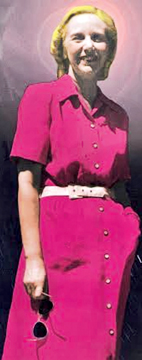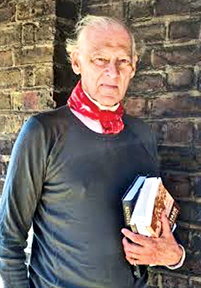|
Anna Kavan (1901-1968)
An extraordinary life
The first time I read anything by Anna Kavan was a short excerpt ‘A
Visit’ – from her book ‘Julia and the Bazooka’ published posthumously in
1970 – two years after she died.
“One hot night a leopard came into my room and lay down on the bed
beside me. I was half asleep, and did not realise at first that it was a
leopard.
|

Anna Kavan |
I seemed to be dreaming, the sound of some large, soft-footed
creature padding quietly through the house, the doors of which were wide
open because of the intense heat.
It was almost too dark to see the lithe, muscular shape coming into
my room treading softly on velvet paws, coming straight to the bed
without hesitation, as if perfectly familiar with its position.
“A light spring, then warm breath on my arm, on my neck and shoulder,
as the visitor sniffed me before lying down.
It was not until later, when moonlight entering through the window
revealed an abstract spotted design, that I recognised the form of an
unusually large, handsome leopard stretched out beside me.
“His breathing was deep though almost inaudible. He seemed to be
sound asleep. I watched the regular contractions and expansions of the
deep chest, admired the elegant relaxed body and supple limbs, and was
confirmed in my conviction that the leopard is the most beautiful of all
wild animals ... While I observed him, I was all the time breathing his
natural odour, a wild primeval smell of sunshine, freedom, moon and
crushed leaves, combined with the cool freshness of the spotted hide,
still damp with the midnight moisture of jungle plants.
I found his non-human scent, surrounding him like an aura of
strangeness, peculiarly attractive and stimulating.
My bed
“My bed, like the walls of the house, was made of palm-leaf matting
stretched over short bamboos, smooth and cool to the touch, even in the
great heat.
It was not so much a bed as a room within a room, an open staging
about twelve feet square, so there was ample space for the leopard as
well as myself.
I slept better that night than I had since the hot weather started,
and he too seemed to sleep peacefully at my side.
“The close proximity of this powerful body of another species gave me
a pleasant sensation that I am at a loss to name.
“When I awoke in the faint light of dawn, with the parrots screeching
outside, he had already got up and left the room.”
|

Sir Christopher Ondaatje (OC, CBE) |
Reading this sensuous story prompted me to delve into her
extraordinary life. Wanting to be judged solely on her creative output –
which was considerable – she destroyed almost all of her personal
correspondence including her diaries except for a short eighteen-month
period.
Changed her name
She changed her name, doctored her records with intent to mislead,
and anticipated becoming the “world’s best-kept secret: one that would
never be told.” She almost succeeded.
Anna Kavan died on December 4, 1968 putatively of heart failure but a
victim of a lifetime’s addiction to heroin. She had been preparing to
inject herself with a shot of the liquid, which was still in the barrel
of the syringe.
The plunger had not been depressed and she collapsed with the needle
in her arm. She had a long history of attempted suicide and a propensity
as a serious user to overdose.
Nevertheless she was a gifted writer and a talented painter who
endured an unhappy childhood, two failed marriages, and a long mutually
dependent relationship with her psychiatrist.
She was born Helen Emily Woods on April 10, 1901 in Cannes and in the
first of a series of familial rejections was sent away soon after she
was born to be cared for by a nurse, before returning to live with her
parents in West London.
Denied any parental affection (she was allowed to see her mother for
ten minutes each evening before dinner) - she was harshly introduced to
the emotionally cold world that would adversely affect her for the rest
of her life.
When she was six she was sent to an American boarding school, where
for the next seven years she suffered an excruciating sense of betrayal,
alienation and acute loneliness.
American boarding school
She was often left in the school during holidays. When she was
fourteen her father killed himself, after which her mother reacted
against the social stigma of suicide by removing her from her American
boarding school and sending her to others, first in Switzerland and then
in England.
Four years later she was offered a place at Oxford but her socially
scheming and egotistical mother dissuaded her from accepting the place
and instead forced her to marry the lascivious Donald Ferguson, who was
twelve years her senior and who took her to Burma, where he was an
engineer on the railways. It was a disastrous decision both
psychologically and sexually, which led in time to her extreme reaction
against social convention.
She began writing and gave birth to her son Bryan during her
short-lived and explosive marriage to the alcoholic Ferguson. In 1923
Kavan left Ferguson and returned to the UK with her son. Living alone in
London in the mid-1920s she began studying painting at the London
Central School of Arts and Crafts and continued painting throughout her
life.
|

An illustration for her leopard story ‘A Visit’ |
Eventually she published six novels under her married name Helen
Ferguson between 1929 and 1937, some of it about her tropical hell in
Burma. But first, there was a new relationship and possible, though not
recorded, marriage to another bohemian alcoholic Stuart Edmonds of
independent means. She was now using cocaine heavily to compensate for
the messy relationship, which also ended before the 1940s.
As part of her desire in later life systematically to eliminate the
facts of her past Anna Kavan destroyed everything she recorded about her
troubled life, and in the twenty-five years in which she lived under the
alias of Anna Kavan, she expressed little or no interest in the novels
she had published. From the 1940s onwards Anna Kavan, a name she took
from one of the fictional characters in her 1935 novel ‘A Stranger
Still’, had no room in her life for Helen Ferguson.
What followed was a tortuous addictive life involving numerous
relationships before she embarked on a long inseparable telepathic bond
with her psychiatrist Dr Karl Theodor Bluth, who advocated the use of
drugs as an incentive to poetic vision.
Kavan’s dependency on Bluth, not only as the source of her privately
scripted heroin but an inseparable friend ended only on his death in
1964. The trust of this unusual relationship even extended to their
having agreed on a suicide pact.
Kavan’s numerous breakdowns, serious suicide attempts, devoted
attraction to gay men, phobias, obsessions, hospitalisations,
impoverishment, loneliness and courage was none the less compounded by
the need to write and her work is now admired for the intensity of its
vision by novelists as different as J.G. Ballard and Doris Lessing.
Certainly the publication of her masterpiece ‘Ice’ in 1967, a year
before she died, helped considerably to enhance her literary reputation.
In her last years she finally intersected with an audience receptive to
how she saw the world. Her niche in cult literature is secure, and this
is how she would have wanted to be remembered.
She had no wish to be identified by facts and there is little doubt
that she would have rejected the inevitable biography ‘A Stranger on
Earth’ authored by Jeremy Reed and published in 2006 of the acclaimed
but esoteric author.
(Source: The Sri Lankan ANCHORMAN, Toronto, Canada) |

